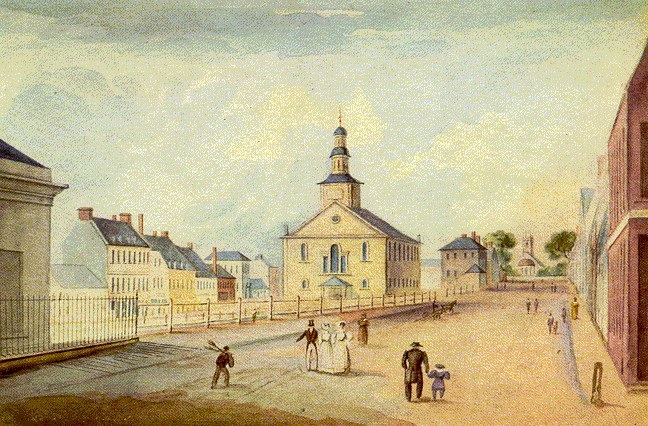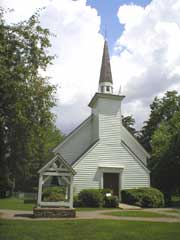Useful links
A history of Canada in the format of a short but substantial on-line book begins here, from the Canadian Heritage Gallery, which appears to have some kind of government connection.
The Dictionary of Canadian Biography online. Search your subject.
A ten-page PDF file (requires Acrobat Reader) on Britsih Protestant Christianity in Canada before Confederation, from Gerry Ediger (a TST doctoral graduate) at Canadian Mennonite University, Winnipeg.
The black church in Canada, by Denise Gillard, a TST (Emmanuel) doctoral student.
A survey of black Baptists in early Nova Scotia.
An 1880 survey of Scottish ministers in British North America.
An 1885 history of Presbyterianism in Canada.
Nathan Banks' huge history of the Methodist Episcopal Church, originally an American church which spread into Canada
The religious history of Canada, written in 1948 by W.S. Wallace.
The origins of Methodism in Newfoundland, by Hans Rollman of Memorial University
Methodists in Wellington County
A short biography of John Stuart, father of Anglicanism in Ontario, and sketches of his son's lives.
The Methodist tradition in Canada, by Victor Shepherd of Tyndale Seminary
A biographical sketch of Egerton Ryerson, an influential Ontario Methodist, also by Shepherd
Ryerson as educator, from the Ryerson University archives
Ryerson, from the Dictionary of Canadian Biography online
John Strachan, from Dictionary of Canadian Biography online
Print bibliography
}
Before 1793
Some Anglicans, Congregationalists, and Quakers worshipped in Newfoundland in the seventeenth century, and the Anglican Cathedral of St. John the Baptist, St. John's, Newfoundland, traces its history to 1699.
A chaplain served the Anglican garrison at Annapolis Royal from 1710,
 which
begins the Anglican presence in Nova Scotia. With the British decision
to build up a town around the garrison at Halifax, the Anglican church
of St.
Paul's was built there in 1749, the oldest Protestant church
building in Canada still in use. (This representation
from about 1831 is by William Eager, 1796-1839.) Other Anglican, German
Lutheran, and Presbyterian congregations followed.
which
begins the Anglican presence in Nova Scotia. With the British decision
to build up a town around the garrison at Halifax, the Anglican church
of St.
Paul's was built there in 1749, the oldest Protestant church
building in Canada still in use. (This representation
from about 1831 is by William Eager, 1796-1839.) Other Anglican, German
Lutheran, and Presbyterian congregations followed.
Baptists trace their origins to a religious revival led by Henry Alline between 1776 and 1783. Some say that the revival was an important reason why Nova Scotia decided not to join the American Revolution.
With substantial immigration from Scotland, the first Church of Scotland presbytery was formed in Truro, Nova Scotia, in 1786, and the second in Pictou in 1795; they joined to form a synod in 1817.
 The loyalist
immigration after the American Revolution begins the first really substantial
period of Protestantism in what is now Canada. Among the loyalists were
the Mohawks under Chief Joseph Brant; their church of St. Paul's at Brantford
(pictured left) was the first Protestant church built in Ontario (1785).
The loyalist
immigration after the American Revolution begins the first really substantial
period of Protestantism in what is now Canada. Among the loyalists were
the Mohawks under Chief Joseph Brant; their church of St. Paul's at Brantford
(pictured left) was the first Protestant church built in Ontario (1785).
A Church of England diocese of Nova Scotia was created in 1787, with its first bishop, Charles Inglis.
Methodist ministers, at first based in the United States, established circuits during this period. The first Methodist church in Ontario is at Hay Bay, near Napanee; it was built in 1791.
From 1793 to 1854
The Church of England was established by statute in Nova Scotia, New Brunswick, and Prince Edward Island, and glebe land was reserved for the support of the clergy. The Constitutional Act of 1791, which created Upper and Lower Canada, stopped short of establishing the Church of England three, but did set aside a huge amount of land for the "Protestant clergy," which at first was assumed to mean Anglican clergy. This land was the source of considerable contention until 1854, when it was secularized by the local legislature. The Church of England was formally supported by the British Parliament and by English missionary societies, which in some ways assisted it, but also prevented it from achieving independent governance and a strong local base of support. The Church of Scotland, being the other established church in Britain, sought privileges in British North America comparable to those of the Church of England. The Methodists were often seen by colonial officials and Anglican leaders as American-inspired, republican-inclined subversives, but their religious structures were well adapted to frontier life, and by the 1830s Methodists outnumbered Anglicans.
The Hudson's Bay Company, which (in British eyes) owned the northwest of the continent, invited a Presbyterian minister around 1814, under the influence of Lord Selkirk, a Scottish philanthropist who had bought into the Company. The minister never arrived. Roman Catholic clergy did arrive. An Anglican minister arrived in 1820; this was John West, who started the first Protestant congregation in the area, as well as the first Indian residential school.
 Here's a map of British
North America around 1823. See the
original site at Natural Resources Canada for a legend and explanation.
Here's a map of British
North America around 1823. See the
original site at Natural Resources Canada for a legend and explanation.
}